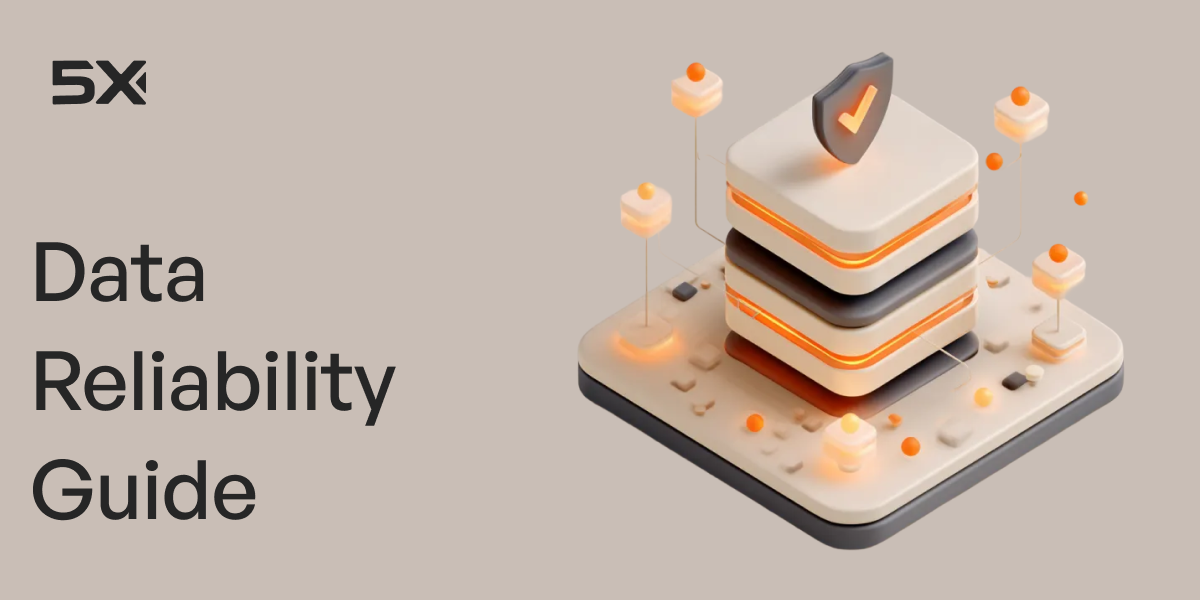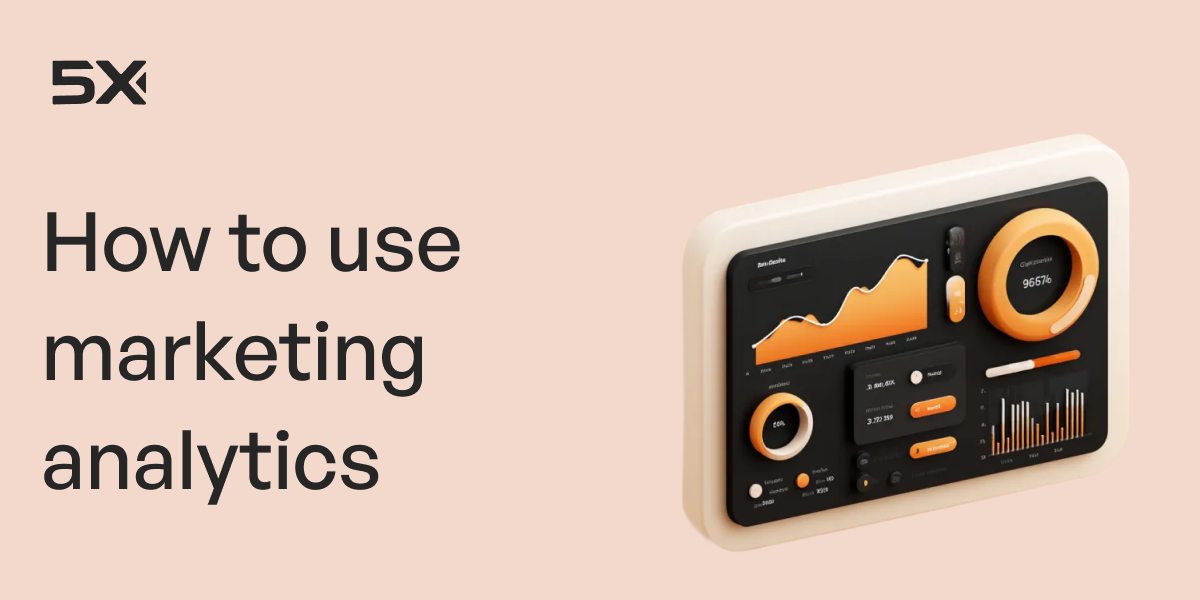How a semantic layer powers trusted, AI-driven analytics

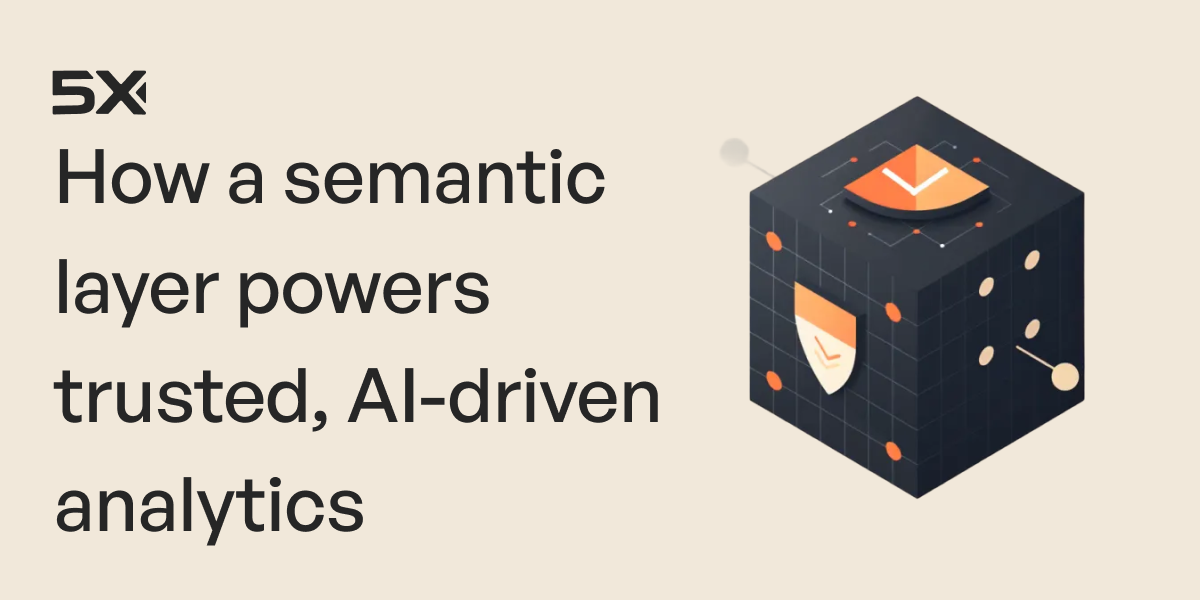

Table of Contents
TL; DR
You already know the promise of AI-driven decision-making: faster answers, cleaner insights, fewer bottlenecks. But if you’ve tried applying GenAI to your own business data, you’ve probably run into the same wall everyone else hits first: your AI can talk, but it can’t be trusted.
Ask it for revenue. You get three different numbers depending on the source.
Ask it for customer count. It hallucinates a metric that doesn’t exist in your systems.
Ask it for churn. It invents a definition.
Not because the AI is incapable, but because your data environment is fragmented, inconsistent, and full of conflicting definitions.
That’s where a semantic layer becomes non-negotiable.
A semantic layer gives your AI and analytics stack what it’s been missing: context, consistency, and shared meaning. It ensures that “revenue” means the same thing in Finance, Sales, the BI dashboard, and your AI assistant. It eliminates the reconciliation wars. And it finally lets leaders make decisions from a single, unified source of truth without building a massive internal data engineering function.
In this post, we’ll explore how a semantic layer creates a common business language for your data, why it’s the difference between AI that hallucinates and AI that drives results, and how it empowers data leaders, analytics teams, and governance stakeholders alike.
Why your data platform must include a semantic layer
Every modern business grapples with fragmented data. Sales has its CRM, Finance its spreadsheets, Marketing its automation tools; each system full of metrics that don’t always line up.
In traditional setups without a semantic layer, each analytics tool or dashboard might define metrics differently. Imagine one dashboard defining “Active Users” as users logged in the past 30 days, while another uses 90 days. Both are “correct” in isolation, but together they create confusion and erode trust.
Traditional BI tools often suffer this fate, as every team or report can accidentally invent its own version of the truth. The result is decision chaos: meetings spent debating whose numbers are right instead of making business moves.
A semantic layer fixes this by acting as a central business logic hub. It’s an abstraction that sits atop your raw data and translates technical data into consistent business terms like “customer”, “net revenue”, “churn rate” with clearly defined calculations and contexts.
Integrating a semantic layer also addresses the data integration challenge at its core. Enterprises have a mix of structured and unstructured data, from databases to documents. A semantic layer helps link these disparate sources by their real-world meaning, not just their raw format.
Interesting bit:
A reddit poll shows that a bunch of organizations still don’t have a semantic layer but the ones that do, are using it to their advantage especially for governance.
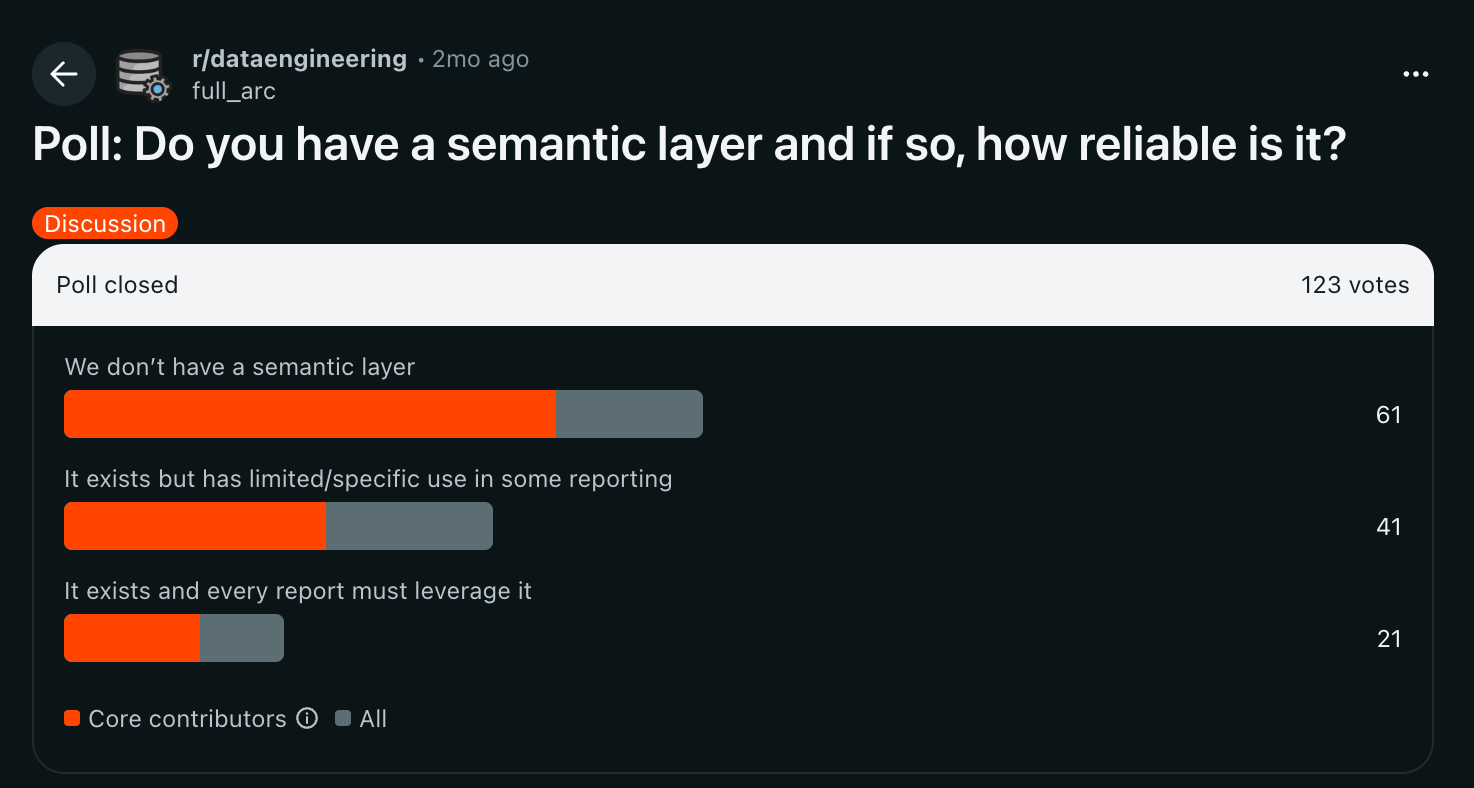
Also read: Data integration automation: How to eliminate manual ETL and speed up insights
How the semantic layer enables generative AI and analytics
Generative AI is powerful, but it has a blind spot: it has zero understanding of your business unless you feed it structure and meaning.
That structure = the semantic layer.
A reddit user described this so well:
I implement semantic layers for many companies and I like them. imo they're relatively underhyped because a lot of people think you can just throw all the data in an LLM's context and do magic but in reality getting good performance out of AI systems requires a fair bit of data standardization and semantic enrichment. If you have more specific questions I can answer but idk what you're trying to figure out.
what a semantic layer actually does for GenAI
- Gives AI the business context it lacks definitions, relationships, calculations, constraints
- Prevents the classic failure mode: “Right question. Wrong data. Wrong answer.”
- Cuts hallucinations dramatically by grounding the model in approved logic, not guesses
Without a consistent semantic context, an AI might answer the right question with the wrong data.
~ Willem Koenders, Global Leader, ZS
Meaning and metadata: Why semantic layers are key to generative AI success
A well-implemented semantic layer is essentially anti-hallucination medicine for AI. It provides the AI models with a grounding context, a map of your business terms, their definitions, and the relationships between them.
Research shows that connecting GPT-4 to a semantic layer (in the form of a knowledge graph) boosted its accuracy on business questions from a mere 16% to 54% —that’s a 3× improvement in accuracy.
This isn’t just about GenAI; analytics gets a massive lift too
- Every BI surface—Looker, Tableau, PowerBI, Excel—reads from one standard definition set
- No reconciling dashboards. No “why does Finance’s number not match Marketing’s?”
Governance becomes automatic instead of an afterthought
- Access rules live in the semantic layer, not in scattered tools
- Examples:
- Sales VP sees client-level revenue
- Senior leadership sees full breakdown
- AI copilot only sees aggregated values (no PII leakage)
- Every query by human or AI automatically respects governance policies
The decision-making advantage
- Executives get instant, reliable answers without Slack-chains, mega-threads, or “give us a day to reconcile numbers”
- Ask a question—any tool, any interface—and the answer comes from the same semantic truth layer
At 5X, this fuels:
- AI copilots
- conversational BI
- automated decision workflows
- context-aware chat interfaces
How to choose the right semantic layer
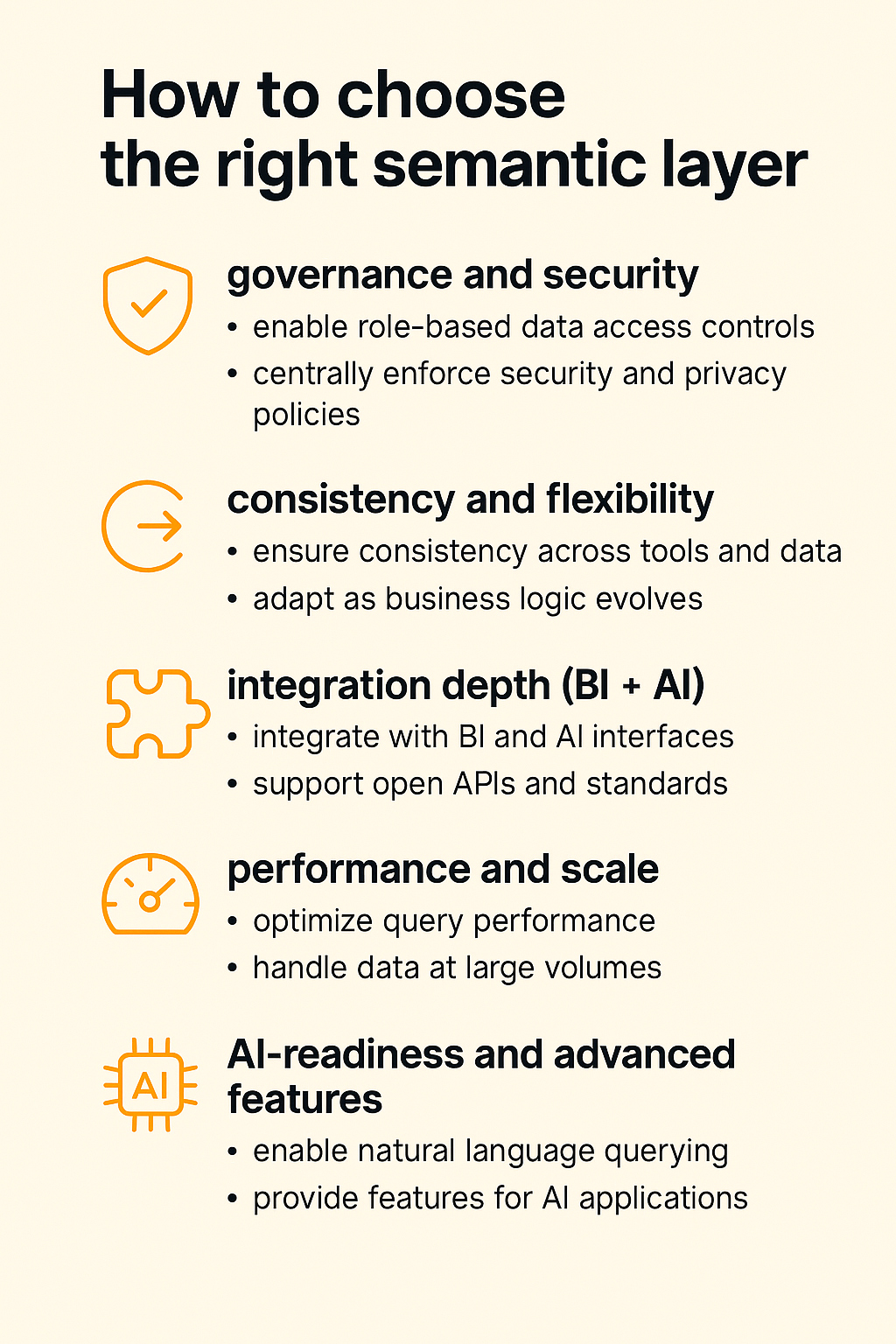
Not all semantic layers (or the tools claiming to provide them) are created equal. As semantic layers become essential for AI-ready data platforms, it’s important to know what to look for when evaluating this capability.
Here are key considerations for choosing the right semantic layer for your needs:
1. Governance and security
At its core, the semantic layer should enable robust data governance. This means it should integrate with your identity and access management, enabling role-based data access controls on metrics and dimensions.
For example, can you restrict a metric to only certain departments? Can it mask or omit sensitive data for certain user groups? A strong semantic layer will let you enforce these policies centrally.
In practice: 5X’s semantic layer ties in fine-grained access controls, so each user or AI agent only sees what they’re permitted to without accidental exposure of sensitive info.
2. Consistency and flexibility
The layer must ensure consistent metrics across all tools, but also be flexible enough to adapt as business logic evolves. Look for the ability to update a definition in one place and have it propagate everywhere.
If marketing redefines “active user” from 30-day to 90-day window, you should update the semantic model once and immediately all reports and AI answers follow the new definition.
Prioritize solutions that decouple the semantic layer from any single BI tool. The future (and increasingly the present) is a semantic layer built directly into the data platform or warehouse, rather than locked inside one reporting tool. This ensures it can serve any downstream application.
Industry trend: experts see semantic layers moving into the warehouse for better scalability and adoption.
3. Integration depth (BI + AI)
The right semantic layer will be deeply integrated with both your analytics tools and your AI/LLM interfaces. Check if it has open APIs or standards support (like SQL, MDX, or even GraphQL) that allow AI agents to query it directly.
Does it work with your BI dashboards (Tableau, PowerBI, Looker) out-of-the-box? And can it feed context to LLMs or AI solutions? When evaluating semantic layers, prioritize openness and interoperability.
For instance, 5X offers an open, modular semantic framework that works across your data warehouse, BI tools, and GenAI applications without locking you into a proprietary ecosystem. In fact, 5X is built on an open-source foundation to ensure you’re never trapped (a critical factor when technology evolves quickly).
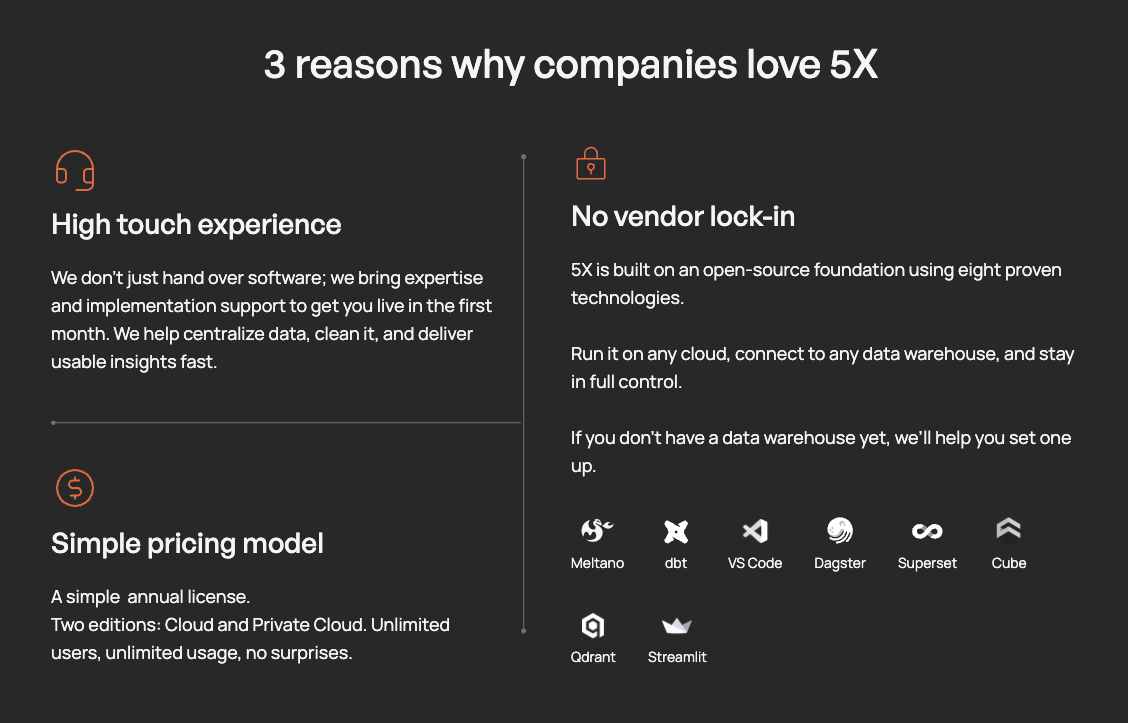
4. Performance and scale
Semantic layers add an abstraction, so they must be engineered for performance. Look for things like query optimization, caching, or push-down computation (where the heavy lifting is done by the underlying data warehouse).
The layer should handle your data scale, whether that’s millions or billions of rows, without becoming a bottleneck. When asking vendors, inquire about how their semantic layer architecture ensures low-latency responses for both BI queries and AI-driven queries. A bonus is support for real-time or streaming data in the semantic model, if your use cases need up-to-the-minute insights.
5. AI-readiness and advanced features
Since our goal is to enable AI-driven analytics, consider features that help large language models use the semantic layer. This might include natural language query translation, where the semantic layer can interpret a question like “Show me revenue by product for Europe” and map it to the right fields and filters.
Some modern platforms embed LLM-friendly interfaces on top of the semantic layer. Also, features like retrieval-augmented generation (RAG) compatibility (providing semantic context for LLMs to retrieve) can be a plus for building AI applications.
Also read: How AI agents are transforming data analytics for enterprises
How 5X’s semantic layer helps you meet your needs
To see these principles in action, let’s zoom in on 5X’s approach.
5X is a modern Data & AI platform that was designed from the ground up with an embedded semantic layer. Instead of treating the semantic layer as an add-on, 5X makes it a foundational part of the data stack.

Here’s how 5X’s semantic layer addresses the key needs of mid-sized enterprises looking for trusted, AI-ready analytics:
1. Unified business metrics and definitions
5X’s semantic layer centralizes your business glossary and metrics definitions in one place. This means everyone from a data engineer building a pipeline to a CEO looking at a dashboard sees the same numbers calculated the same way.
If you define “Customer Acquisition Cost” or “Annual Recurring Revenue” in 5X, that definition is applied across all your analytics surfaces. This eliminates the “multiple versions of truth” problem by ensuring consistent business intelligence across the board.
As 5X customers often note, this consistency builds immediate trust; teams spend less time arguing over numbers and more time acting on insights.
2. Role-based data governance built in
Governance is not an afterthought in 5X. The semantic layer in 5X is tightly integrated with role-based access control and security policies. You can define, for example, that regional managers can see revenue for their region only, or that an AI sales assistant can query customer data but not see personally identifiable information.
These rules are enforced at the semantic layer level, meaning no matter how data is accessed (via a BI report, an API, or an AI chatbot), the answers always respect your governance policies. This gives peace of mind to your security and compliance stakeholders. They get fine-grained control, while your business users get fast, self-service insights without waiting on approvals or manual data prep.
3. Integration with GenAI copilots and LLMs
A standout feature of 5X’s semantic layer is that it’s AI-native. It provides an API-ready structure that your generative AI tools can plug into easily.
Whether you’re building an internal ChatGPT-style assistant for querying company data or deploying an AI “copilot” for your analysts, 5X feeds them the context they need.
The semantic layer exposes business concepts and their relationships in a way that AI models can consume, acting as that crucial “source of truth” grounding.
In 5X, the semantic layer doesn’t just support BI; it fuels enterprise-grade AI agents and copilots that understand your business. For example, if you ask a question in natural language, “What’s our profit margin on product X this month?,” 5X’s AI integration ensures the query is interpreted against the correct governed metrics (margin, product hierarchy, time filter) and returns a reliable answer, not an AI shot in the dark.
4. Open, modular, no lock-in
5X’s semantic layer is built on an open-source foundation, aligning with the platform’s philosophy of no vendor lock-in. For you, this means flexibility. You’re not forced into a single vendor’s ecosystem or format.
5X’s semantic definitions can interoperate with standards (like dbt’s metrics, or even emerging standards like Open Semantic Interchange). If you have an existing data warehouse, 5X can layer on semantics without requiring you to move all your data. And if you ever needed to migrate, your business logic isn’t trapped in a black box.
This openness also makes 5X’s semantic layer future-proof. As new analytics tools or AI frameworks emerge, they can connect to 5X via standard interfaces and immediately leverage the semantic layer.
It’s an investment that grows with you.
5X is built by data leaders who recognized the need for trust in AI. Explore customer stories to see how companies like yours are using 5X to deliver consistent, trusted AI-driven analytics.
FAQs
Building a data platform doesn’t have to be hectic. Spending over four months and 20% dev time just to set up your data platform is ridiculous. Make 5X your data partner with faster setups, lower upfront costs, and 0% dev time. Let your data engineering team focus on actioning insights, not building infrastructure ;)
Book a free consultationHere are some next steps you can take:
- Want to see it in action? Request a free demo.
- Want more guidance on using Preset via 5X? Explore our Help Docs.
- Ready to consolidate your data pipeline? Chat with us now.
Get notified when a new article is released
Simplify your data

How retail leaders unlock hidden profits and 10% margins
Retailers are sitting on untapped profit opportunities—through pricing, inventory, and procurement. Find out how to uncover these hidden gains in our free webinar.
Save your spot






%201.svg)
